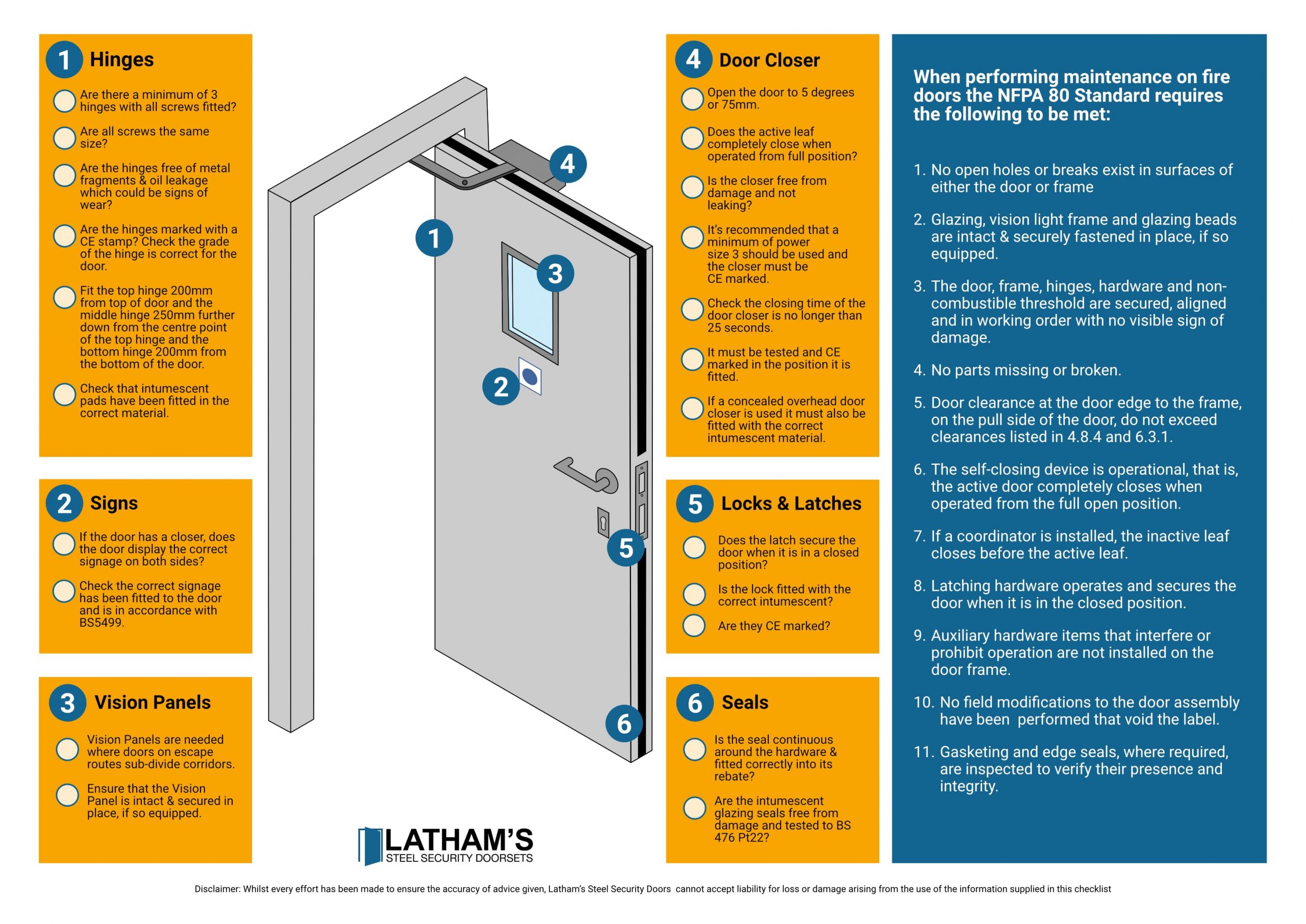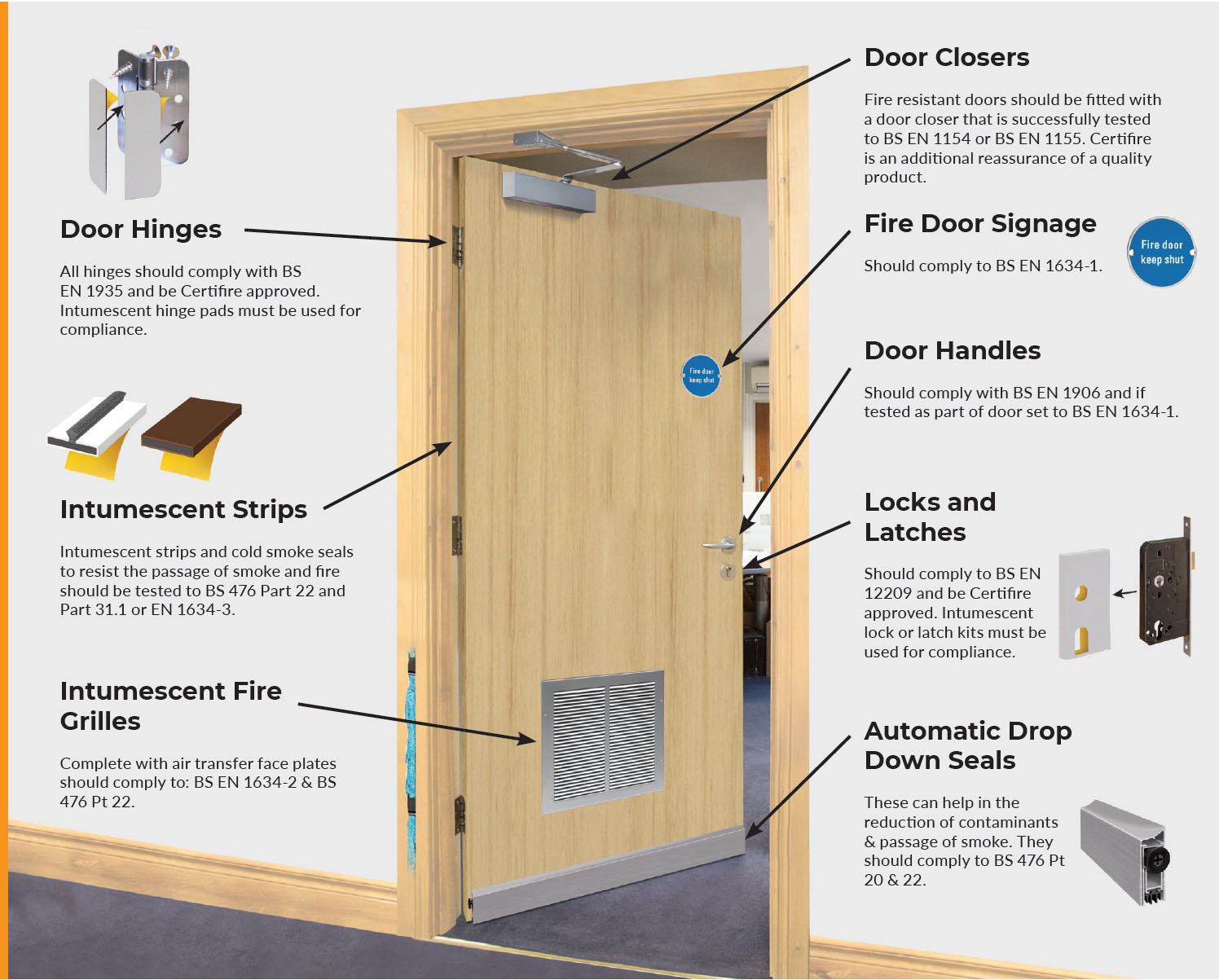Understanding Fire-Rated Bedroom Doors

Fire-rated bedroom doors are an essential safety feature in residential buildings. They are designed to delay the spread of fire and smoke, providing valuable time for occupants to escape. These doors act as a crucial barrier, slowing down the fire’s progress and giving residents a chance to evacuate safely.
Fire Ratings, Fire rated bedroom doors
The fire rating of a bedroom door indicates its ability to resist fire for a specific duration. It is measured in minutes, with common ratings ranging from 20 minutes to 60 minutes. The higher the fire rating, the longer the door can withstand fire and heat before failing.
- A 20-minute fire rating indicates that the door can withstand fire and heat for at least 20 minutes before it fails, providing occupants with additional time to escape.
- A 30-minute fire rating signifies that the door can withstand fire and heat for at least 30 minutes, offering a longer window for safe evacuation.
- A 60-minute fire rating represents the highest level of fire resistance, ensuring that the door can withstand fire and heat for at least 60 minutes, providing maximum protection for occupants.
Components of a Fire-Rated Door Assembly
A fire-rated door assembly is composed of several critical components that work together to provide fire resistance:
- Door Leaf: The door leaf is the main component of the assembly. It is constructed from fire-resistant materials such as solid core wood, steel, or fiberglass. These materials are designed to resist fire and heat, preventing the spread of flames and smoke.
- Frame: The door frame is the surrounding structure that holds the door leaf in place. It is typically made of steel or wood and is also fire-resistant. The frame is designed to maintain its integrity under fire conditions, preventing the door from collapsing.
- Hardware: The hardware includes hinges, handles, and latches. These components are specifically designed to withstand fire and heat, ensuring that the door can be opened and closed even in a fire situation.
- Seals: Fire-rated doors incorporate seals around the door leaf and frame. These seals are made of fire-resistant materials that expand when exposed to heat, creating a tight seal that prevents smoke and fire from entering the room.
Types of Fire-Rated Bedroom Doors

Fire-rated bedroom doors are essential for safety, but choosing the right type can be tricky. There are various options, each with unique advantages and disadvantages. This section explores the different types of fire-rated bedroom doors, comparing and contrasting their features, and highlighting their strengths and weaknesses.
Solid Core Doors
Solid core doors are known for their exceptional fire resistance. These doors are constructed with a solid core of wood, usually a dense hardwood like oak or maple. They are often chosen for their strength, durability, and ability to withstand intense heat and flames.
- Advantages: Solid core doors are the most fire-resistant type, offering excellent protection against fire spread. They are also very sturdy and durable, making them a good choice for high-traffic areas. Their solid core also provides better sound insulation, reducing noise transmission between rooms.
- Disadvantages: Solid core doors are typically the heaviest and most expensive option. They can be difficult to install and require more specialized tools. They also have limited aesthetic options, with designs mostly restricted to traditional styles.
Hollow Core Doors
Hollow core doors are built with a lightweight core of honeycomb or foam, making them lighter and less expensive than solid core doors. They are commonly used in residential settings due to their affordability and ease of installation.
- Advantages: Hollow core doors are lighter and easier to install than solid core doors, making them a budget-friendly option. They are also available in a wider range of styles and finishes, offering more design flexibility.
- Disadvantages: Hollow core doors offer less fire resistance compared to solid core doors. They are also not as soundproof, allowing noise to pass through more easily. Their lighter construction can make them less durable, particularly in high-traffic areas.
Composite Doors
Composite doors are a combination of materials, often featuring a core of engineered wood or foam, covered with a fire-resistant veneer or fiberglass. They offer a balance between fire resistance, cost, and aesthetics.
- Advantages: Composite doors offer a good balance between fire resistance, cost, and aesthetics. They are more fire-resistant than hollow core doors but less expensive than solid core doors. They also come in various styles and finishes, allowing for more design options.
- Disadvantages: Composite doors may not be as fire-resistant as solid core doors, and their durability can vary depending on the materials used. They may also be susceptible to moisture damage, requiring proper maintenance.
Installation and Maintenance: Fire Rated Bedroom Doors

Installing fire-rated bedroom doors correctly is crucial for ensuring their effectiveness in preventing fire spread. Proper installation involves adhering to building codes and using the right tools and techniques. Regular maintenance and inspections are equally important to guarantee the doors’ continued functionality and safety.
Installation Procedures
Installing fire-rated doors requires meticulous attention to detail to ensure they function as intended. Here’s a breakdown of the essential steps:
- Preparation: Before installation, clear the area around the door opening and check for any obstructions. Verify that the door frame is properly sized and leveled. Ensure the door itself is in good condition, free from damage, and fits snugly within the frame.
- Framing: Install the door frame securely, using screws or nails that are long enough to penetrate the wall studs. The frame should be plumb and level, providing a stable foundation for the door. This step is critical for a proper fit and sealing.
- Hinge Installation: Attach the hinges to the door and frame, ensuring they are aligned and secured properly. The hinges should be robust enough to support the door’s weight and allow for smooth operation.
- Door Installation: Hang the door on the hinges, making sure it swings freely and closes tightly. Adjust the hinges as needed to achieve proper alignment. The door should close without any gaps or excessive friction.
- Hardware Installation: Install the door handle, lockset, and other hardware components. Ensure that these components are compatible with the door and frame and are installed securely.
- Sealants and Gaskets: Apply fire-resistant sealant around the door frame and doorjamb to create a tight seal. Install fire-rated gaskets around the door to further prevent smoke and flames from entering the room. These sealants and gaskets are essential for maintaining the door’s fire-resistance rating.
- Final Inspection: After installation, inspect the door for any gaps or misalignments. Test the door’s operation to ensure it closes smoothly and latches securely. This step is crucial for ensuring the door’s functionality and fire-resistance performance.
Maintenance and Inspection
Maintaining fire-rated doors is an ongoing responsibility that contributes significantly to their longevity and effectiveness. Regular inspections and maintenance ensure these doors continue to perform their critical role in fire safety.
- Regular Inspections: Conduct visual inspections of the door and frame at least once a year. Look for signs of damage, wear, or corrosion. Check the door’s operation, making sure it opens and closes smoothly without any binding or sticking. Examine the hinges for any looseness or wear.
- Sealant and Gasket Check: Inspect the fire-resistant sealant and gaskets around the door and frame. Look for any cracks, gaps, or damage. Ensure that the sealant and gaskets are intact and providing a tight seal. Replace any damaged or worn components immediately.
- Hardware Check: Inspect the door handle, lockset, and other hardware components for signs of wear or damage. Ensure that they are functioning properly and securely attached. Replace any faulty components promptly.
- Door Closure Test: Test the door’s closure mechanism regularly. Ensure that the door latches securely and that the latching mechanism is working correctly. Any issues with the latch or closure mechanism should be addressed immediately.
Homeowner Checklist
Here’s a checklist for homeowners to ensure their fire-rated bedroom doors are functioning correctly:
- Visual Inspection: Check for any signs of damage, wear, or corrosion on the door and frame.
- Door Operation: Ensure the door opens and closes smoothly without any binding or sticking.
- Hinge Inspection: Examine the hinges for any looseness or wear.
- Sealant and Gasket Check: Inspect the sealant and gaskets for any cracks, gaps, or damage.
- Hardware Check: Ensure the door handle, lockset, and other hardware components are functioning properly and securely attached.
- Door Closure Test: Test the door’s closure mechanism to ensure it latches securely and the latching mechanism works correctly.
Fire rated bedroom doors offer peace of mind in case of a fire, but they also provide an extra layer of security. If you’re concerned about safety at night, you might consider locking your bedroom door at night for added protection.
Fire rated doors, with their robust construction and self-closing features, can help keep you safe in various situations, from accidental fires to potential intrusions.
Fire rated bedroom doors are essential for safety, but that doesn’t mean they can’t have a touch of personality! Add a playful touch to your home with some bedroom door signs funny , like “Warning: May contain snacks” or “Enter at your own risk”.
These signs are a great way to express yourself and add a bit of humor to your home’s decor, while still maintaining the vital safety of fire rated doors.
